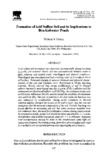Formation of acid sulfate soil and its implications to brackishwater ponds

រកមើល / បើក
កាលបរិច្ឆេទ
1995អ្នកនិពន្ធ
Page views
520ទិន្នន័យមេតា
មើលកំណត់ត្រាលម្អិតនៃធាតុCited times in Scopus
Share
អរូបី
Acid sulfate soil formation was observed experimentally during leaching of pyritic soil material. Pyritic soil was saturated with distilled water in glass columns and treated under waterlogged and drained conditions. Waterlogged was inundated and had overlying water of 2-cm depth above soil surface. Temporal changes of various chemicals and physical characteristics of the soil and leachates were determined at 10-day leaching intervals. Results showed that strong acidification of soil in drained column but not in waterlogged was due to pyrite (FeS2) oxidation and the consequent production of sulfuric acid (H2SO4). As oxidation progressed, acidification influenced the pH, and increased the solubility of aluminum (Al) and iron (Fe). The loss of potassium (K) and sulfur (S) fractions was also enhanced by acidification. Strong acidic condition in drained columns slightly changed the texture of the soil to more clay, but was not enough to alter the mineral composition of the soil. Periodic leaching was found effective in increasing soil pH, but some essential nutrients were also removed, thus, the need for fertilization scheme during amelioration. In prospective ponds, pyritic soil should be tilled and dried for 2–3 weeks, then flushed and drained repeatedly until pH > 5 is obtained. Repeated lime incorporation should be done in the amelioration until high pH values are obtained. In existing ponds, formation of acid sulfate soil could be avoided by not excessively turning and exposing the pond bottom.
Suggested Citation
Golez, N. V. (1995). Formation of acid sulfate soil and its implications to brackishwater ponds. Aquacultural Engineering , 14(4), 297-316. https://doi.org/10.1016/0144-8609(94)00008-O
ប្រធានបទ
បណ្តុំបណ្តុំ
- AQD Journal Articles [1248]
